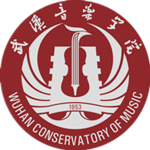School Badge

About Wuhan Conservatory of Music
Wuhan Conservatory of Music (WHCM) is the only independently established music institution of higher education in central China. Located at Wuchang district with long history and humanities fair, the conservatory has two campuses–one lies at No. 255 Jiefang Road, and the adjacent one at No.1 Zhang Zhidong Road, Wuchang district, Wuhan city, Hubei province.The history of WHCM can be traced back to Music Academy in Central-South China which was established in 1953 by the agglomeration of the music sectors of Central-South Academy of Literature and Art, People’s Literature and Art Academy in South China, and Guangxi Provincial Art College. Specifically, Central-South Academy of Literature and Art can be traced back to Literature and Art Academy of Chung Yuan University, and Wuchang Art College which was took over by Chung Yuan University in 1949, and Literate and Art Academy of Hunan University which was merged in 1950; People’s Literature and Art Academy in South China was composed of Guangdong Provincial Art College, Art College of Guangzhou City, and Hong Kong Chinese Music Academy; Guangxi Provincial Art College can be traced back to Guangxi Provincial Art Teachers’ Training Class, etc. All of these contribute to the conservatory’s historical inheritance of music education with a rich variety and a solid foundation. In 1958, Music Academy in Central-South China and Wuhan Normal College of Art were merged into Hubei Art Academy (from 1972 to 1978 it was named Hubei Art College). In 1985, it transformed to Wuhan Conservatory of Music.
We are dedicated to cultivating moral ethics in students, improving popular art educational level, maintaining the function of elite education in order to demonstrate a satisfactory conservatory to the public. We carried out a Trinitarian policy of discipline construction combining artistic performance, artistic creation, and theoretical research. Sticking to the conservatory motto of cultivating moral ethics, promoting self-improvement, advocating culture and polishing artistic skills, Wuhan Conservatory of Music is committed to cultivating music talents of high quality, versatility and innovation.
WHCM is one of the earliest conservatories which have been authorized to confer master’s degrees. It currently offers two master degree programs—Master of Fine Arts (MFA) and Master of Laws (Marxist Theory·Ideological and Political Education). The conservatory focuses on full-time undergraduate and postgraduate education, and carries out other types of education based on social needs. The teaching institutions of our conservatory include the department of Composition, Musicology, Chinese Music, Piano, Orchestra, Vocal Studies, Dance, Music Education, Acting and Performing, Postgraduate Education, Political Education, Public Elementary Education, Continuing Education (including Adult Education), affiliated middle school and primary school. Thus, it establishes an education level ranging from primary school, middle school, undergraduate education, postgraduate education, to PhD education.
The conservatory owns a national-level Experimental Teaching Demonstration Center of Musical Performance, which is one of the only two national-level demonstration centers in the aspect of music, and 3 national specialties in the aspects of Musicology, Recording Art, and Musical Performance. The conservatory is among the first batch of Hubei provincial construction institutions of key disciplines, and is one of “The Research Institutions of Humanities and Social Sciences” of Hubei Province. The conservatory also establishes several platforms for professional development, including Hubei provincial key disciplines of music and dance and Hubei provincial collaborative innovation center of music innovation; and several platforms for artistic practice, like Oriental Symphonic Orchestra, Oriental Chinese Orchestra, Chimes Orchestra, Oriental Chorus, and Oriental Dance Troupe; as well as an achievement publication — the journal Huangzhong, one of the 8 core GCJC of music. Making full use of these platforms, the Conservatory is innovating mechanisms for talents cultivation, improving cultivation quality, and promoting cultural inheritance and innovation to better serve national economic, social and cultural development.
The history of WHCM can be traced back to Music Academy in Central-South China which was established in 1953 by the agglomeration of the music sectors of Central-South Academy of Literature and Art, People’s Literature and Art Academy in South China, and Guangxi Provincial Art College. Specifically, Central-South Academy of Literature and Art can be traced back to Literature and Art Academy of Chung Yuan University, and Wuchang Art College which was took over by Chung Yuan University in 1949, and Literate and Art Academy of Hunan University which was merged in 1950; People’s Literature and Art Academy in South China was composed of Guangdong Provincial Art College, Art College of Guangzhou City, and Hong Kong Chinese Music Academy; Guangxi Provincial Art College can be traced back to Guangxi Provincial Art Teachers’ Training Class, etc. All of these contribute to the conservatory’s historical inheritance of music education with a rich variety and a solid foundation. In 1958, Music Academy in Central-South China and Wuhan Normal College of Art were merged into Hubei Art Academy (from 1972 to 1978 it was named Hubei Art College). In 1985, it transformed to Wuhan Conservatory of Music.







